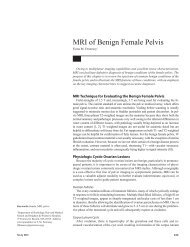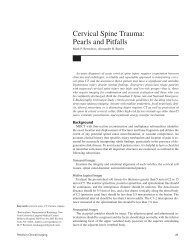Scientific Session 1 â Breast Imaging: Mammography
Scientific Session 1 â Breast Imaging: Mammography
Scientific Session 1 â Breast Imaging: Mammography
You also want an ePaper? Increase the reach of your titles
YUMPU automatically turns print PDFs into web optimized ePapers that Google loves.
<strong>Scientific</strong> <strong>Session</strong> 15—General/Emergency RadiologyWednesdayHowever, 100% of the CT studies were rated either “4” or “5” by bothreviewers, indicating no loss in diagnostic value of the study.Conclusion: HDCT may allow rapid image acquisition without a significantincrease in image noise, albeit with some loss of perceived imagequality. However, the reduction in image quality in this study was unlikelyto significantly alter the diagnostic value of the scan. For patients inwhom a shorter scan acquisition time is likely to reduce motion artifacts,HDCT may be a useful technique. Future studies may be indicated tofully assess the impact of HDCT for the ability to reduce motion artifacts.131. Conventional Dacryocystography in Epiphora: Does the RoadEnd Here?Jaganathan, S.*; Sharma, S.; Thulkar, S.; Kumar, A.; Pushker, N.; Bajaj,M. All India Institute of Medical Sciences, New Delhi, IndiaAddress correspondence to S. Jaganathan (sriramjsrini@yahoo.co.in)Objective: Conventional dacryocystography (DCG) is being consideredas the reference standard in the evaluation of patients presenting withepiphora. In our study we evaluated the role of CT DCG and MR DCG incomparison with conventional DCG.Materials and Methods: Bilateral nasolacrimal systems (NLS) were prospectivelystudied in 25 consecutive subjects (21 male, 4 female) withuni- or bilateral epiphora using conventional and CT DCG. T1-weighted(18 patients, 36 NLS) and T2-weighted (20 patients, 40 NLS) MR DCGwas done using topical gadopentetate dimeglumine and saline, respectively.Images were evaluated for status of NLS and associated crosssectionalfindings. Conventional DCG was used as reference standard.Results: Causes of epiphora in 25 patients were infection (7/25, 28%), trauma(13/25, 52%), failed dacryocystorhinostomy (DCR) (3/25, 12%), andcongenital (2/25, 8%). Sensitivity and specificity for diagnosing NLS obstructionwere 100% each on CT DCG; 100% and 93.7%, respectively, onT2-weighted MR DCG; and 100% and 91.7%, respectively, on T1-weightedMR DCG. On T1-weighted MR DCG, 19 of the 36 NLS were obstructed(52.8%); 11 were patent (30.6%); and imaging was technically unsuccessfulin six (16.7%). Obstruction at the nasolacrimal sac–nasolacrimal duct junctionwas seen in 26 systems (86.7%) on CT and conventional DCG and in20 (80%) on T2-weighted MR DCG. Almost perfect agreement was foundbetween CT and T2-weighted MR DCG for presence (κ = 1) and level ofobstruction (κ = 0.8). Additional information influencing management includeddetection of relevant fractures, thickened frontal process of maxillaafter trauma, enlarged agger nasi cells, and abnormal surgical bony ostiumin the failed DCR group. CT DCG unequivocally showed fractures of facialbones in six of 13 patients (35.2%) that could be suspected only in four of13 patients (23.5%) on conventional or T1-weighted MR DCG. CT DCGshowed bony ostium in all three, MR DCG in two, and conventional DCG innone. Degree of confidence in its evaluation was low on MRI. Both CT andT2-weighted MR DCG showed agger nasi cells in one of 25 patients (4%),not seen in conventional DCG. Based on imaging, external DCR was done in14 NLS, intubation DCR in 12, and dacryocystectomy in four NLS.Conclusion: NLS could be demonstrated equally well on CT, T2-weighted MR and conventional DCG (traditional reference standard).T1-weighted MR DCG is not reliable for NLS evaluation. DCG needs tobe combined with CT to define anatomical relation of sac with adjacentfracture(s), bony ostium, and agger nasi cells in posttraumatic and failedDCR patients. We recommend CT DCG as a modality of choice in posttraumaticand failed DCR patients with epiphora.132. Reduction of Dose to The Female <strong>Breast</strong> in Thoracic CT:Comparison Between Bismuth Shields and Posteriorly CenteredPartial CT Scans in a PhantomTappouni, R.*; Moser, K.; Leibig, S.; Mathers, B. Penn State HersheyMedical Center, Hershey, PAAddress correspondence to R. Tappouni (raftappouni@gmail.com)Objective: Posteriorly centered partial CT, also known as organ-baseddose modulation CT, avoids exposing the breast directly as the tubeswitches on during 232° out of 360° per rotation. The purpose of thisstudy was to evaluate the potential for dose reduction to the female breastin chest CT in two techniques using an anthropometric phantom: bismuthshield and posteriorly centered partial CT.Materials and Methods: Four calibrated thermoluminescent dosimeters(TLDs) were placed on the anterior and posterior surface of an anthropometrictorso phantom (RS 310 lung/chest phantom, Fluke Biomedical).The phantom underwent a baseline chest CT scan with tube currentmodulation (TCM) using a 128-slice MDCT scanner (Siemens MedicalSolutions). This was repeated using breast shields (F&L Medical), 0.060-mm Pb equivalent, placed onto the four anterior TLDs after the topogram.Finally, the scan was repeated using posteriorly centered partialCT. Scan parameters for the first two scans were 120 kVp, 110 mAs reference,pitch of 1.2, and rotation time of 0.5 second and for the thirdscan 120 kVp, 110 mAs reference, pitch of 0.6, and rotation time of 0.28second. The readings from the three sets of eight TLDs were recordedin addition to effective dose and CT dose index (CTDI) for each scan.Results: The average dose for anterior and posterior TLDs for TCM were686 and 602 mrad, breast shield were 426 and 606 mrad, and for posteriorlycentered partial CT were 590 and 826 mrad. The average effective mAsand CTDI, respectively, for TCM were 88 mAs and 5.99 mGy, for breastshield were 87 mAs and 5.93 mGy, and for posteriorly centered partial CTwere 95 mAs and 6.47 mGy.Conclusion: Posteriorly centered partial CT reduces dose to the breastby 16% on expense of an 8% increase in overall radiation dose. Bismuthbreast shields reduced dose by 38% without an increase in overall radiationdose. Use of bismuth shields is the preferred technique to reduceradiation to the female breast.133. Habitus Dependency on Iodine Quantification ComparingSequential Single-Energy Subtraction Versus Spectral Dual-EnergyExtraction: Phantom Study Assessing Filtered Backprojection andIterative Reconstruction SchemesFeuerlein, S.*; Boll, D. Duke University, Durham, NCAddress correspondence to S. Feuerlein (sfeuerlein@yahoo.com)Objective: To compare the accuracy of iodine quantification by single-phasedual-energy CT (DECT) and a conventional dual-phase HU-based subtractionmethod and to evaluate the influence of a reduction of image noise bythe use of iterative reconstruction on the accuracy of iodine quantification.A50*Will present paper
















